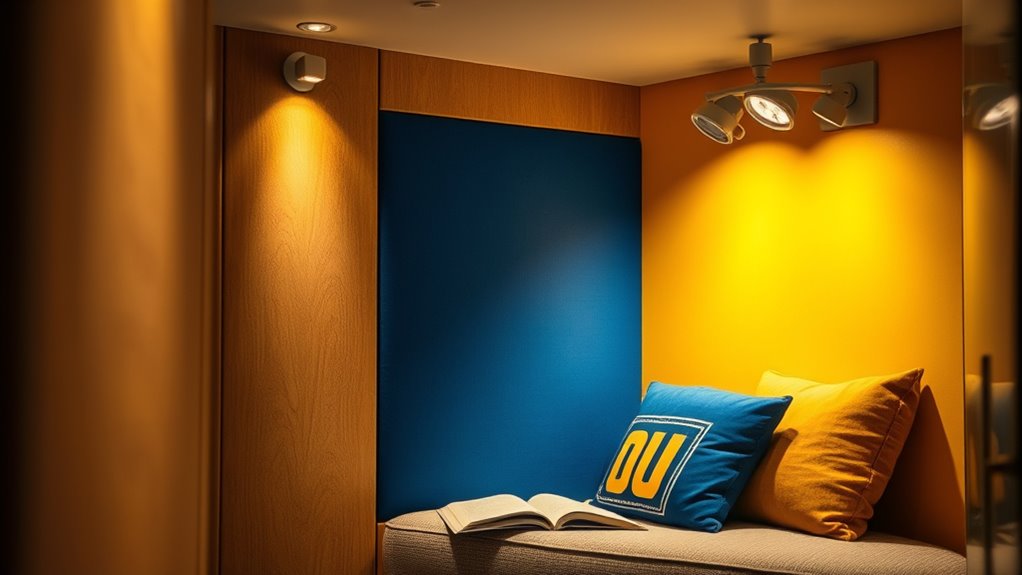To improve visibility with low vision, you should focus on proper lighting and environmental modifications. Use bright, glare-free LED lights and add task lighting to specific areas like your reading or workspace. Position lamps directly over surfaces and incorporate reflective surfaces to bounce light around. Adjust lighting with dimmers to suit your needs and consider adaptive devices like magnifiers or electronic aids. Small changes can make a big difference—continue exploring for practical tips to enhance your everyday environment.
Key Takeaways
- Use bright, glare-free LED lighting with dimmable options to customize brightness levels.
- Incorporate task lighting directly on work surfaces for detailed activities like reading or sewing.
- Position lamps to avoid harsh glare and reflect light with light-colored walls or mirrors.
- Install larger, high-contrast switches and touch controls for easier operation.
- Combine environmental modifications with adaptive technology to optimize visibility and safety.

When managing low vision, proper lighting can make a significant difference in your daily life. It’s essential to optimize your environment with strategies that enhance visibility and reduce eye strain. One effective approach involves incorporating adaptive technology designed specifically for low vision needs. These devices, such as magnifiers with built-in lights, electronic visual aids, or voice-activated assistants, can amplify your remaining vision and make tasks like reading, cooking, or orienteering easier. Adaptive technology acts as a personalized solution, allowing you to customize lighting levels and contrast settings to suit your specific requirements. By integrating these tools into your routine, you gain more independence and confidence in handling everyday activities.
Environmental modifications are equally vital. Adjusting your surroundings to maximize light exposure can greatly improve your ability to see clearly. Start by increasing ambient lighting in key areas—use bright, glare-free overhead lights or multiple light sources to eliminate shadows and dark corners. Position lamps so that the light shines directly onto your work surface without creating harsh glare, which can be problematic for low vision. Consider adding task lighting in places where you perform detailed activities, such as reading or sewing, to provide focused illumination. Installing larger, high-contrast switch plates or touch-sensitive controls can also make it easier to operate lighting fixtures without struggles. These modifications create a safer, more comfortable environment by reducing visual clutter and making important objects stand out.
You should also think about the placement and type of bulbs you use. LED bulbs tend to provide brighter, more consistent light without flickering, which can be distracting or uncomfortable. Dimmable lights give you control over brightness levels, allowing you to adjust lighting based on the task or time of day. Incorporating reflective surfaces, such as light-colored walls or mirrors, can help bounce light around the room, increasing overall brightness naturally. Keep in mind that reducing glare is critical; using matte finishes on walls and furniture can prevent unwanted reflections that impair your vision. Additionally, understanding how essential oils can support overall well-being might contribute to a more relaxed environment, indirectly benefiting your visual comfort.
Choose LED and dimmable bulbs, and use matte finishes to reduce glare and improve visibility.
Combining adaptive technology with thoughtful environmental modifications creates a holistic lighting strategy tailored to your needs. These adjustments not only improve visibility but also foster a sense of independence and safety. As you explore different lighting solutions, remember that small changes can have a profound impact. By actively managing your environment and utilizing adaptive technology, you can vastly enhance your ability to navigate your world confidently and comfortably each day.
Frequently Asked Questions
How Can I Determine the Best Lighting for My Specific Low Vision Condition?
To find the best lighting for your low vision, start by consulting an eye care professional who can recommend custom lighting solutions tailored to your needs. Experiment with adaptive illumination options like brighter bulbs, adjustable fixtures, or task lighting. Pay attention to how different lighting conditions improve visibility and comfort. This personalized approach helps you create an ideal environment that enhances your vision and reduces strain.
Are There Any Portable Lighting Options Suitable for Low Vision Individuals?
Your search for portable lighting options is like hunting for a needle in a haystack, but there are great choices out there. You can easily find portable lamps and rechargeable flashlights designed for low vision individuals. These devices are lightweight, adjustable, and rechargeable, making them perfect for reading or steering in dim environments. With these tools, you’ll boost your confidence and independence wherever you go.
How Does Color Temperature Affect Visibility for Those With Low Vision?
Color temperature considerably impacts your visibility by affecting color perception and visual contrast. Cooler temperatures (around 5000K-6500K) enhance clarity and make objects stand out more, which is helpful for low vision. Warmer temperatures (around 2700K-3000K) may reduce contrast, making it harder to distinguish details. Adjusting your lighting to a higher color temperature can improve your ability to perceive colors accurately and improve overall visibility.
Can Lighting Improvements Help With Specific Tasks Like Reading or Cooking?
Lighting improvements can considerably enhance your ability to perform tasks like reading or cooking. You should consider task-specific lighting, which focuses illumination directly where you need it, reducing shadows and glare. Adaptive illumination systems allow you to adjust light levels easily, optimizing visibility for each activity. These strategies help you see more clearly, making daily tasks safer and more comfortable, especially when tailored to your specific needs.
What Are the Common Mistakes to Avoid When Setting up Lighting for Low Vision?
You should avoid common mistakes like poor light placement and neglecting glare reduction. Place lights close to your work area, aiming for even illumination that minimizes shadows. Keep lights at appropriate angles to reduce glare, which can cause discomfort and impair vision. Don’t rely solely on overhead lighting; incorporate task lighting where needed. Regularly adjust your lighting setup to guarantee ideal brightness and comfort, enhancing your ability to see clearly and perform tasks safely.
Conclusion
To make the most of your environment, use targeted lighting and minimize glare. Studies show that proper lighting can improve reading speed by up to 30% for those with low vision. Remember, small changes like adjusting brightness or adding task lighting can make a big difference in your daily life. Don’t hesitate to experiment with different lighting setups—finding what works best will help you see more clearly and confidently every day.









